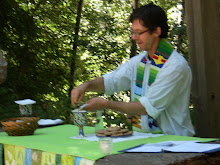On the afternoon of Thanksgiving Day,
after a large meal of the traditional foods, some of the guys and I walked down
the country road where my uncle lives to visit the neighbor’s house. We met the neighbor, a short guy named Lou
with about ten teeth and a big beer gut, and stood around outside with him and
his son for a while, admiring his new solar-electric array, and then we got
invited in. Before we’d gone over there,
my cousin Kirk, whose idea it was for the visit, had said “in case of the
zombie apocalypse, Lou’s is the place to meet up”, and now I got to
see what he meant. First we went into the back room to inspect a
couple of family heirlooms, a Civil War-issue Springfield rifle and a
buffalo-hunting gun that Kirk’s great-grandfather brought West, and that he’d
given to Lou for safe-keeping. After
that our host reached into his desk and started pulling out sidearms. From there we went to the bedroom where Lou
produced one weapon after another from the drawer in the nightstand and the back
of the clothes closet.
I did my best to stay cool and as
each gun was passed into my hands I obligingly nodded and looked it up and down
and sighted along the barrel at the pine tree outside the window, but I was way
out of my depth. I’ve never discharged a
firearm in my life, and don’t have any desire to do so. And I’d met gun nuts before, but never in
their natural habitat. Still there was
something innocent about my uncle’s neighbor, something childlike about the way
he showed us his special toys, rolling around on his bed among the cartridges
and magazines he’d pop out for safety’s sake, and laughing and pushing away a
pug dog that kept trying to lick his face. “My only problem,” he said, “is I have so many
guns that if anyone ever did try to break into my house, I wouldn’t know which
one to use.” And we all laughed, imagining
a guy in a ski-mask coming through the window, and him saying “hold on a sec, buddy…
now let’s see—the Baretta or the Colt 45? The semi-automatic shotgun, or the AK-47?”
It’s black humor but in a funny way
Lou’s joke makes the same point that Jesus does in the Gospel of Matthew when
he talks about the owner of the house who would have stayed awake and not let
his house be broken into, if he had only known in what part of the night the
thief was coming. My uncle’s neighbor has
enough guns for a small army. I heard on
the radio the other day that now you can get a home-security system that lets
you watch live video surveillance of your front door on your smart phone while
you’re at the restaurant pretending to have a conversation with your wife. But in spite of all the preoccupations and precautions
that you take, the thief comes at an hour that you don’t expect.
The New Testament is strangely
ambiguous about the whole question of the end of the age. For instance, in today’s Gospel, why does he
describe an interruption in normal, everyday activities, that affects some
people and not others, when elsewhere in Matthew he talks about great
tribulations and awesome portents in the heavens. And what about the two men in the field and
the two women at the mill—which are we supposed to want to be, the one who is
taken or the one who is left? And in
what sense would Jesus be “coming back” when he has already said that when two
or three are gathered together in his name he will be in the midst of them, and
the last words of Matthew’s Gospel are “lo, I am with you always, even to the end
of the age.”
Modern critical scholars like to explain
that these are different layers of tradition, and that the early Christian
communities kept changing their opinions as the so-called “Second Coming” didn’t
come. But they didn’t feel right about just
discarding older predictions of Jesus’ imminent return, so they made up new
ones to reflect a different understanding and just kind of shuffled them into
the story. But I think there’s something
more to these ambiguities, and that they have been part of the tradition from
the beginning. Because when you are
talking about the end of the age, the goal of history, the fulfillment toward which
all the parables and practices and precepts of religion are urging us—the final
victory of justice and love over evil and death—the only language that really pertains
is mythic and symbolic language. Only a
surplus of imagery can begin to address this subject, which, of all the themes
in Judeo-Christian scripture, is the one which our ordinary conceptual consciousness
is least able to explain or describe.
I think Jesus knew this, and he
probably said different things on the subject at different times to suit
different audiences; and Matthew knew this, and so he felt free to put those
different sayings together in creative ways for the sake of the story he wanted
to tell. And if these sayings contradict
each other and sow a certain amount of confusion in our minds about just what it
is exactly we’re supposed to believe, that’s really all to the good, because it
leads us back to a point about which the Gospels and the epistles of Paul and
the other documents in the New Testament are in unanimous agreement, with no
ambiguity at all. And that is this—from the
standpoint of what difference does it all make anyhow, and how are you and I to
live today, the only approach to Christ’s coming, and the end of the age, that
makes any practical sense at all is to live as if it were going to happen any minute,
as if, in fact, it is happening now.
This isn’t a position that the
apostolic communities came to later, out of disappointment that the other shoe
still hadn’t dropped. This is the
essential content of Jesus teaching, the whole story of his ministry, the cause
of his death and the meaning of his resurrection—that the New Age, the Kingdom
of God, the Eternal Life of the World to Come, starts now, starts here, today, with
you and with me. Every year at this
time we get ready to tell this story of Jesus again from the beginning, and
every year we start by giving away the ending.
So if the point of the story were simply to know how it ends so that we
can plan ahead, so that we can fill our closets with guns, and our minds with certainties,
so that we won’t be taken unawares, we might as well stop right there. Because no one knows the day or the hour.
But we do tell the story, and it
never gets old because it is not meant simply to be interpreted, it is meant to
be contemplated, to be taken deep into our hearts and into the life of our
communities, to shape our thoughts and our speech and our actions. It is meant to be lived. And that is something we are completely free not to do. Jesus’ own disciples were free not to do that,
and, in fact, they didn’t. They missed
the point even though Jesus was right there in front of them, telling them,
showing them the Kingdom of God. But the
disciples kept waiting for something else, just like the Pharisees, asking for their
sign, wondering when something amazing would happen that would tell them that
the big moment had finally arrived. And
like the song says, “Don’t it always seem to go that you don’t know what you’ve
got ‘til it’s gone.”
But God would not let the disciples
of Jesus rest in their failure to understand.
Missing the point is no excuse, because the end of the world isn’t over
until it’s over. And that’s where the
church comes in. That’s where you and I
come in, almost 2,000 years later, when we’re still waiting. We’re still waiting, which means there’s
still a chance for us to wake up and stop waiting. The Son of Man is still coming, which means
we still have the chance to wake up and see that he’s already here. No one knows when the thief is going to break
in, but we believe that he’s still out there somewhere, so we still get up on
Sunday mornings and come over to this funny old building to listen and to pray
and to watch and to hope that today is the day.


No comments:
Post a Comment